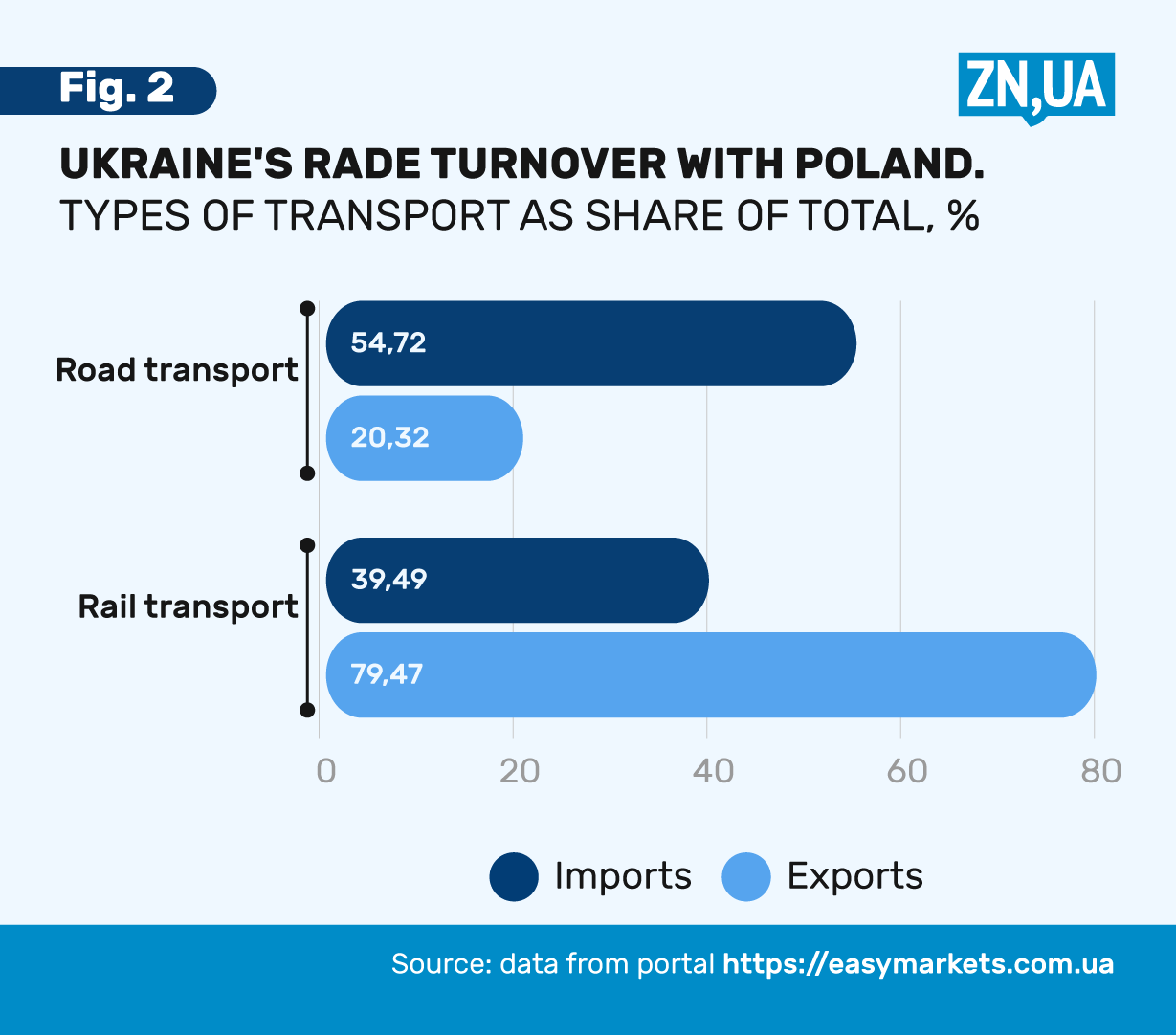Border Blockade. What Should Be Explained to Poles to Stop It

Ukraine is under siege. Since the beginning of the full-scale invasion of the Russian Federation, it has been deprived of most of the usual logistical routes. Since Polish transporters blocked four border points, the same has been true for most freight roads because of all the neighboring countries, Poland has the largest number of them.
Rafal Mekler, the organizer of the protest on the border with Ukraine, says that Polish carriers intend to block the Ukrainian-Polish border until February 1, 2024 – that is, for two more months. The queue of trucks has now stretched for more than 30 km, about 3,000 drivers have been waiting for weeks to cross the border. Two of them have passed away. While their death probably did not result from waiting in the queue, spending this wintery week in a car definitely did not improve their health.
On November 21, Slovak carriers joined the blockade, but they were quickly brought to their senses by the Slovak police as the strike was not authorized by anyone. Nevertheless, the Association of Motor Carriers of Slovakia still does not rule out the possibility of joining their Polish colleagues in case “their protest is fruitless.” Not much of an auspicious prospect for Ukraine.
The Ukrainian Ministry of Infrastructure hopes to achieve success in negotiations with the Polish government regarding the unblocking of the border. However, already with the new government. The leader of the Polish opposition, Donald Tusk, does recognize the damage caused by the blockade for Poland itself and seems to be ready for constructive steps. But these steps should be expected no earlier than mid-December. The current Polish government supports the right to protest guaranteed by democracy. And in order to finally slow down the search for a solution, it asked the EU Commissioner for Transport to set up a joint committee to analyze the situation.
Volodymyr Kravchenko spoke in detail about the demands and motives of Polish carriers, noting in particular that, according to ZN.UA, the Ministry of Infrastructure of Ukraine will not hear about any concessions to the protesters whatsoever. Entering into negotiations with such a position and in the current conditions is challenging, so let's try to enhance the case of the Ukrainian side.
No, we are not referring to the "Russian footprint" in the biography of the protest leader Rafal Meckler. Rather, we are talking about the economic irrationality of his protest, which can be explained by Russian money, but is difficult to justify with business logic.
Since the beginning of the full-scale invasion of the Russian Federation and the resulting logistical problems, our trade relations with Poland have changed drastically.
And the changes are in Poland’s favor.
Polish carriers have more work and, therefore, more revenues. Polish companies are stepping up production and sales. Polish suppliers have an opportunity to buy cheaper and resell more expensively. The Polish state receives more taxes from them all.
Yes, Ukraine is not an ideal partner for many reasons. But the statement that it has created terrible non-competitive conditions on the Polish road freight market is not even an exaggeration – it is an outright lie.
According to the EasyMarkets analytical resource, the export of goods by road transport to Ukraine from the territory of Poland (that is, our imports) in the nine months of this year increased by 53% in physical volumes compared to the same period in 2022 (see Picture 1). Revenues of exporters increased by 57% compared to the three quarters of the previous year and by 79% compared to the same period in 2021.
Everyone has won, both Polish manufacturers and Polish suppliers.
See for yourself: the export of Polish goods to Ukraine increased by 39% in physical terms, and by 43% in monetary terms, or by $1 billion, compared to last year. At the same time, the export of Chinese goods to Ukraine from Poland increased by 78%, American – by 135%, Japanese – by 177% (see Picture 2). All of these are deliveries by road transport only.
It is not only Polish business that is growing, including Polish carriers – the role of Poland as a road transportation hub is also on the rise. This somehow does not quite fit into the arguments about the fears of Poles that Ukrainian drivers will dethrone them as Europe’s number one haulier. On the contrary, their market influence has nothing but increased since the beginning of the full-scale invasion, thanks to the still sizable Ukrainian market, which regularly needs to be filled with goods through our bottlenecky western border.
The income of Polish companies, or at least those registered on the territory of Poland, from exports to Ukraine by road transport for nine months of 2023 amounted to $5.7 billion, which is 2 billion (or 55%) more than for the same period in 2022, and 77% more than in 2021. If we talk purely about domestic benefits, i.e., about the export of Polish-made goods, they account for $3.5 billion of those almost six billion. This leads to GDP growth, new jobs, higher population incomes, and tax collections – all the textbook benefits. This textbook will definitely not include a statement that if your income increases, you have been put in non-competitive conditions. The remaining $2.2 billion are earnings of Poles from the resale of goods from other countries to Ukraine. And they, too, can hardly be interpreted as losses.
It is interesting to see what the admirers of democratic will in the Polish government will do if local manufacturers suddenly protest against the protests of local truckers.
At the same time, we will not see any parity if we look at the volumes of Ukrainian exports to Poland. While truckers are the only ones not to go into the deep red, their surplus is only 3.8% in tons and minus 21% in money, compared to three quarters of last year. Compare it with the indicators of Polish colleagues and feel the difference, as they say. After all, if road transport accounts for more than half of all types of transport by which goods are delivered in Poland, in Ukraine only 20% of goods go to Poland by car and 80% by rail (see Picture 3). Did these 20% create such non-competitive conditions in the domestic Polish market as to cause protests?
Let's take a look at the trend: 2020 — the physical volumes of road transport deliveries grew by 4.7% compared to the previous year, 2021 saw an increase of almost 6%, and here is 2022 — plus 39.9% over the previous year. In nine months of 2023, let me remind you, the growth is already 53%, which means that the record of 2022 will be broken. In other words, after the start of the war, the volume of deliveries via road transport from Poland to Ukraine increased tenfold.
We are grateful to the Poles for the fact that they provide us with everything we need while our domestic producers are coping with the challenges of the war as best they can. We are grateful to the Polish road carriers who help to do this, despite the existing risks. And in no case do we intend to say that someone is making money from our misfortune. However, the fact of earnings as such, spherical in a vacuum, cannot be hidden with posters about possible bankruptcies due to Ukrainian rivals. Gentlemen, bankruptcies are definitely too much.
Polish suppliers also have their fair share: they acquired quite broad opportunities to purchase cheaper Ukrainian goods to resell them on the more expensive European market. And our goods are cheaper not only because of basic component prices, such as labor cost or the cost of electricity; they are also cheaper because of our logistical hopelessness. If Poland is the only available route from a bunch of possible delivery directions, you are happy to sell cheaper to someone who is ready to take the goods through the border just to sell them and not shut down.
And now even this direction is sealed. One day of the blockade costs our companies much more than €300 simply for trucks standing idle because factories are also idle while waiting for the cargo. Even for a three-time-longer-than-usual delivery, they have to pay three times more since there are no people willing to stand in a week-long traffic jam at the old rate. All this will affect our barely alive GDP growth, our domestic prices, whose increase was prevented literally by force, and economic activity in general.
Therefore, on one side of the scale are the benefits received by Polish manufacturers, suppliers and carriers, and on the other side are the pretended losses of Rafal Makler and his friends, the real losses of Ukraine, which have already reached €400 million, and political damage to both states.
It would seem that finding a win-win result under such conditions is easy. We really hope that the Ukrainian side will finally make a convincing case for this, the Polish side will have the strength and the Ukrainian drivers will have the patience.
Read this article in Ukrainian and russian.
Please select it with the mouse and press Ctrl+Enter or Submit a bug














 Login with Google
Login with Google